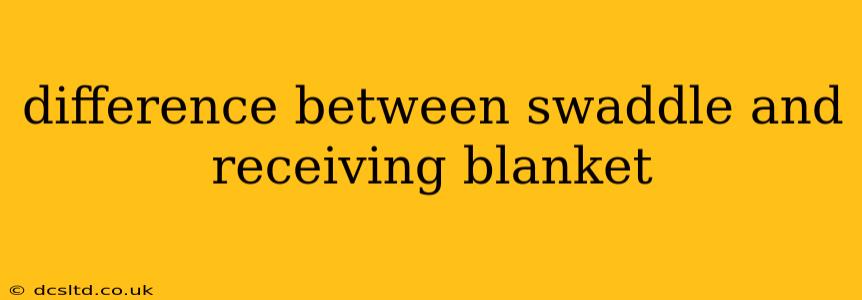Swaddle vs. Receiving Blanket: What's the Difference?
Choosing between a swaddle and a receiving blanket for your little one can feel overwhelming. Both are soft, cozy textiles, but their purposes and designs differ significantly. Understanding these differences is crucial for ensuring your baby's safety and comfort. This guide will clarify the key distinctions between swaddles and receiving blankets, helping you make the best choice for your needs.
What is a Swaddle?
A swaddle is a single piece of fabric designed to wrap your baby snugly, mimicking the feeling of being held. The snug wrap can soothe fussy babies and promote better sleep by reducing the startle reflex. Swaddles typically have either arm openings or are designed to keep the baby's arms tucked in close to the body. They are available in various materials, from lightweight cotton muslin to heavier fleece, depending on the season and your baby's preference.
What is a Receiving Blanket?
A receiving blanket is a larger, square piece of fabric, generally larger than a swaddle. It’s primarily used as a cover for the baby, offering warmth and comfort. Receiving blankets serve multiple purposes, including covering your baby in a car seat, stroller, or crib, or even using it as a burp cloth. They aren't designed to restrict movement in the same way a swaddle is.
What are the key differences between a swaddle and a receiving blanket?
This table summarizes the key differences:
| Feature | Swaddle | Receiving Blanket |
|---|---|---|
| Purpose | To snugly wrap and soothe the baby | To provide warmth and cover the baby |
| Size | Smaller, usually designed for specific body sizes | Larger, square shape |
| Design | Designed to restrict movement (partially or fully) | No restriction of movement |
| Usage | Primarily for sleeping and calming | Versatile: crib cover, car seat cover, burp cloth, etc. |
| Arm Position | Arms can be tucked in, partially out, or fully out (depending on the design) | Arms are free to move |
How do I choose between a swaddle and a receiving blanket?
The best choice depends on your baby's age, preferences, and your needs.
-
Newborns (0-3 months): Swaddles are often preferred for newborns to help soothe them and reduce the startle reflex, leading to longer stretches of sleep. However, always follow safe sleep guidelines.
-
Older babies (3+ months): As babies get older and become more mobile, they often start rolling over. Once your baby shows signs of rolling over, it's generally recommended to stop swaddling to reduce the risk of Sudden Infant Death Syndrome (SIDS). At this stage, a receiving blanket is a safer and more appropriate choice.
-
For warmth and general covering: A receiving blanket is a more versatile option.
When should I stop swaddling my baby?
Most pediatricians recommend stopping swaddling when your baby shows signs of rolling over from back to tummy. This typically happens around 3-4 months old, but every baby develops at their own pace. Continuing to swaddle after this point increases the risk of SIDS. Always prioritize safe sleep practices.
What are the safety guidelines for using swaddles and receiving blankets?
-
Safe Sleep Practices: Always place your baby on their back to sleep on a firm, flat surface. Never put a swaddle or receiving blanket in a crib with a baby who is already able to roll over.
-
Material: Choose breathable fabrics like cotton muslin for both swaddles and receiving blankets, especially during warmer months.
-
Fit: Ensure the swaddle isn't too tight and allows your baby to breathe comfortably.
By understanding the differences between swaddles and receiving blankets and prioritizing safe sleep practices, you can ensure your baby's comfort and safety. Remember to always consult your pediatrician for personalized advice.
